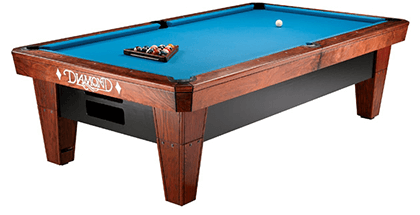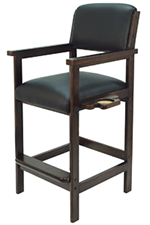The Rules of Play From World Pool-Billiard Association
14.1 Continuous Pool, also known as straight pool, is played with fifteen numbered balls and the cue ball. Each ball pocketed on a legal called shot counts one point and the first player to reach the required score wins the match. 14.1 is continuous in that after fourteen balls are pocketed, they are re-racked and the shooter continues.
4.1 Lagging for the Break
Players lag to determine who will shoot first. (See 1.2 Lagging to Determine Order of Play)
4.2 The 14.1 Rack
For an opening break shot, the fifteen balls are racked in a triangle with the apex ball on the foot spot. When the balls are re-racked, the apex ball is omitted if only fourteen balls are being racked. The marked outline of the triangle will be used to determine whether an intended break ball is in the rack area.

4.3 Opening Break Shot
The following rules apply to the opening break shot:
(b) If no called ball is pocketed, the cue ball and two object balls must each be driven to a rail
or the shot is a breaking foul. (See 8.4 Driven to a Rail.) This is penalized by subtracting two points from the breaker’s score. (See 4.10 Breaking Foul.) The non-breaking player may accept the balls in position or may require the breaker to play another opening break shot, until he satisfies the requirements for an opening break or the non-shooting player accepts the table in position. (See 4.11 Serious Fouls.)
4.4 Continuing Play and Winning the Game
The shooter remains at the table as long as he continues to legally pocket called balls or wins the game by scoring the required number of points. When fourteen balls from a rack have been legally pocketed, play is suspended until the balls are re-racked.
4.5 Shots Required to Be Called
Shots must be called as explained in 1.6 Standard Call Shot. The shooter may call “safety” in which case play passes to the opponent at the end of the shot and any object ball pocketed on the safety is spotted.
4.6 Spotting Balls
All balls pocketed on fouls, or on safeties, or without a called ball having been pocketed, and all balls driven off the table are spotted. (See 1.4 Spotting Balls.) If the fifteenth ball of a rack needs to be spotted and the fourteen balls have not been touched, the fifteenth ball will spot on the apex spot and the referee may use the triangle to assure a tight rack.
4.7 Scoring
The shooter scores one point for legally pocketing a called shot. Each additional ball pocketed on such a shot also counts one point. Fouls are penalized by subtracting points from the offending player’s score. Scores may be negative due to penalties from fouls.
4.8 Special Racking Situations
When the cue ball or fifteenth object ball interferes with racking fourteen balls for a new rack, the following special rules apply. A ball is considered to interfere with the rack if it is within or overlaps the outline of the rack. The referee will state when asked whether a ball interferes with the rack.
(b) If both balls interfere, all fifteen balls are re-racked and the cue ball is in hand behind the head string.
(c) If only the object ball interferes, it is placed on the head spot or the center spot if the cue ball blocks the head spot.
(d) If only the cue ball interferes, then it is placed as follows: if the object ball is in front of or on the head string, the cue ball is in hand behind the head string; if the object ball is behind the head string, the cue ball is spotted on the head spot, or on the center spot if the head spot is blocked.
In any case, there is no restriction on which object ball the shooter may play as the first shot of the new rack.

Table 1. Summary of the Rules for 14.1 Racking Situations
4.9 Standard Fouls
If the shooter commits a standard foul, a point is subtracted from his score, balls are spotted as necessary, and play passes to his opponent. The cue ball remains in position except as noted below. The following are standard fouls at 14.1:
Cue Ball in Hand)
6.3 No Rail after Contact
6.4 No Foot on Floor
6.5 Ball Driven off the Table (All object balls driven off the table are respotted.)
6.6 Touched Ball
6.7 Double Hit / Frozen Balls
6.8 Push Shot
6.9 Balls Still Moving
6.10 Bad Cue Ball Placement
6.11 Bad Play from Behind the Head String for a foul under the second paragraph of 6.11, the
cue ball is in hand behind the head string for the incoming player
6.12 Cue Stick on the Table
6.13 Playing out of Turn
6.15 Slow Play
4.10 Breaking Foul
A breaking foul is penalized by the loss of two points as mentioned under 4.3 Opening Break Shot, as well as a possible re-break. If both a standard foul and a breaking foul happen on one shot, it is considered a breaking foul.
4.11 Serious Fouls
For Rule 6.14 Three Consecutive Fouls, only standard fouls are counted, so a breaking foul does not count as one of the three fouls. A point is subtracted for the third foul as usual, and then the additional fifteen-point penalty is subtracted and the offending player’s consecutive foul count is reset to zero. All fifteen balls are re-racked and the offending player is required to shoot under the requirements of the opening break. For 6.16 Unsportsmanlike Conduct, the referee will choose a penalty depending on the nature of the offense.
4.12 Stalemate
If a stalemate occurs (see 1.12 Stalemate), the players will lag again to determine who will shoot an opening break.


 Free Shipping with Tracking on orders over $100 within the Continental USA.
Free Shipping with Tracking on orders over $100 within the Continental USA. 




